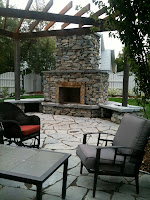Why use groundcover?
Groundcover is used as a means of weed control, because whether or not you like it there will always be weeds. Among other uses, it serves as a substitute for lawn in areas where it is hard to grow. From an aesthetic point of view groundcover will also add a decorative touch to any landscape. No matter what the reason for using groundcover, it is important to understand the pros and cons of the material you choose.In this article we will deal with the two most common forms of groundcover: mulch vs. decorative rock.
Mulch
A covering, as of straw, compost, wood by-product, spread on the ground around plants to prevent excessive evaporation or erosion, enrich the soil, inhibit weed growth, etc.
Pros
- lightweight
- economical
- re-purposing of wood industry waste
- easy to apply
- moisture control
Cons
- Poor control of weeds already in the ground
- Can wash away with water, or blow away with strong winds
- Must be replenished as it breaks down over time
- Will fade from original colour over time
Decorative Rock
A covering, generally applied over a weed barrier material, as of crushed or aggregated stones. Generally a by-product of the quarry industry, also harvested from river and creek beds as well as gravel deposits.Decorative rock can be used as a groundcover to create an alpine feel, or just to add interest and beauty to any landscape. There is a large variety of decorative rock ranging in style, size, and colour. Some popular "Rainbow" rocks are harvested from mountain creeks and rivers, and are rounded and incorporate a range of colours. There is also a good selection of broken, or crushed rock, which tends to be more angular and rustic, and contributes to an alpine theme.
Pros
- Long lasting, fade proof (tends not to break down, with the exception of some shales,)
- Large variety of colours, styles, and sizes
- Regular and larger sized rock will not easily wash or blow away
- Good for water features and dry creeks
- High quality weed barrier underneath is very effective at weed control
- More expensive (price ranges vary significantly)
- Can present opportunity for vandalism
- More difficult and cumbersome to install
- Maintenance required to remove leaves and organic debris from surface
- Poorly suited underneath spruce and other needle bearing trees
Stay informed!
No matter what your choice in ground cover, understanding the pros and cons will help you effectively plan your landscape. Keep in mind that no landscape is maintenance free, but the right groundcover, used in the right way, will keep maintenance to a minimum and enhance your landscape.Happy Landscaping!






